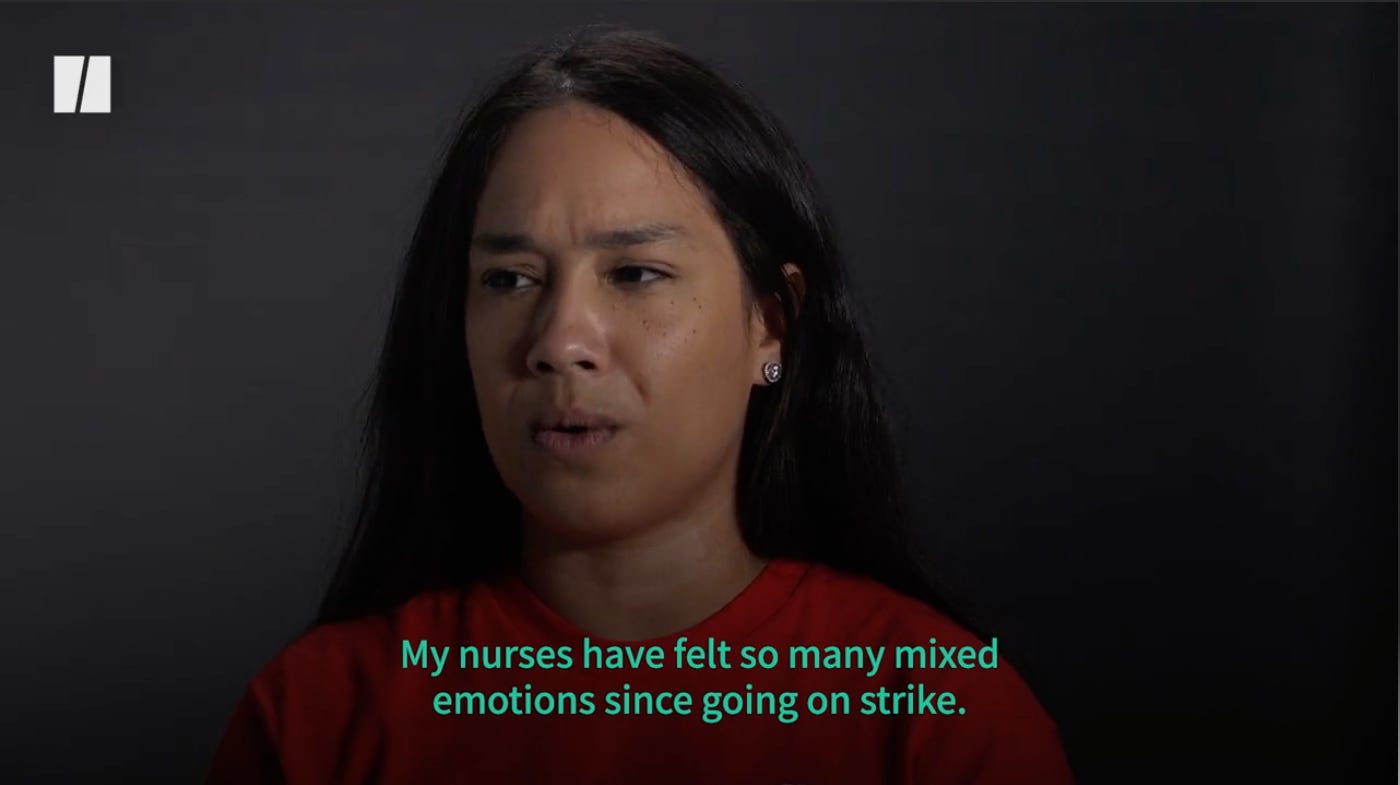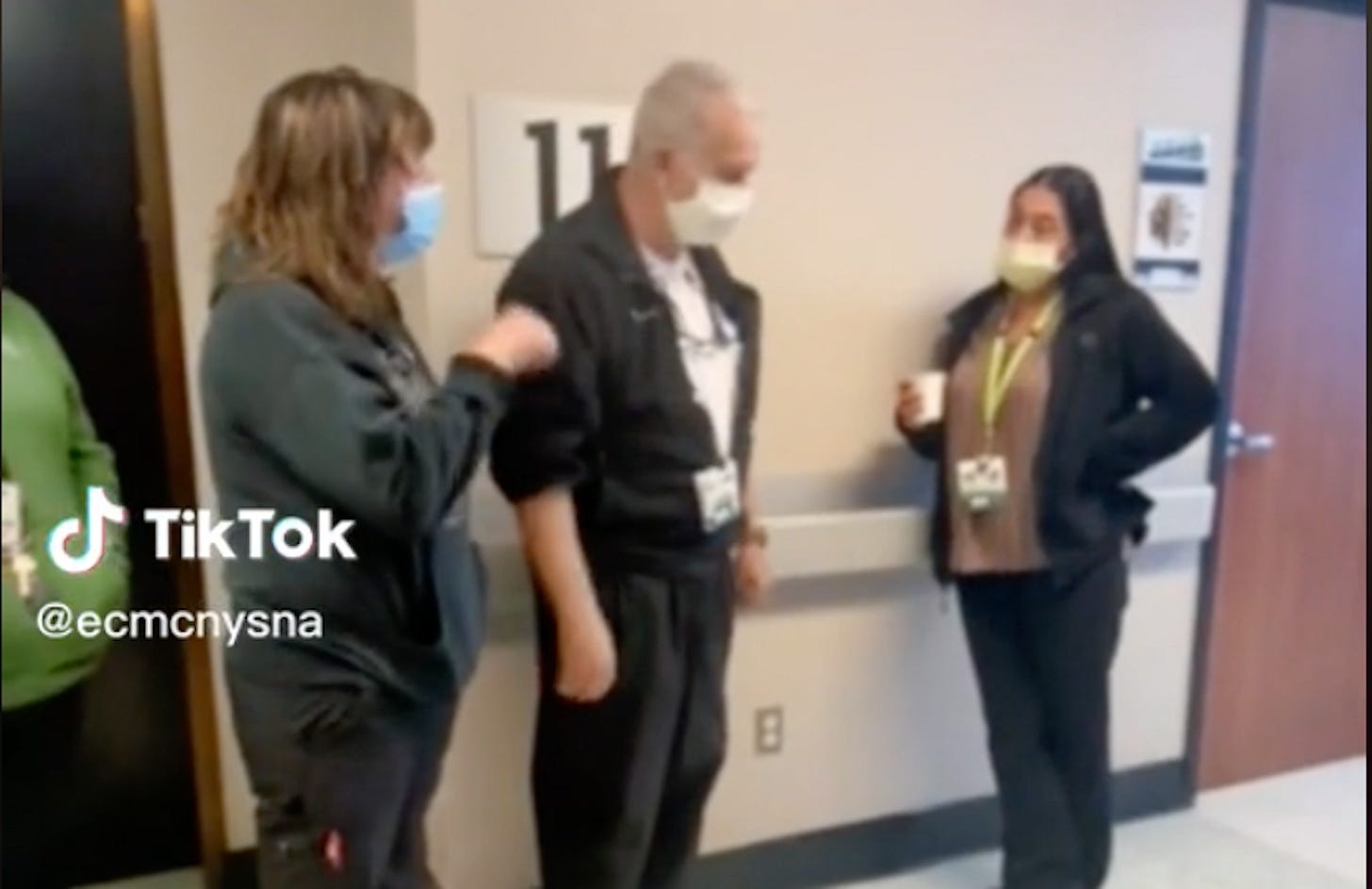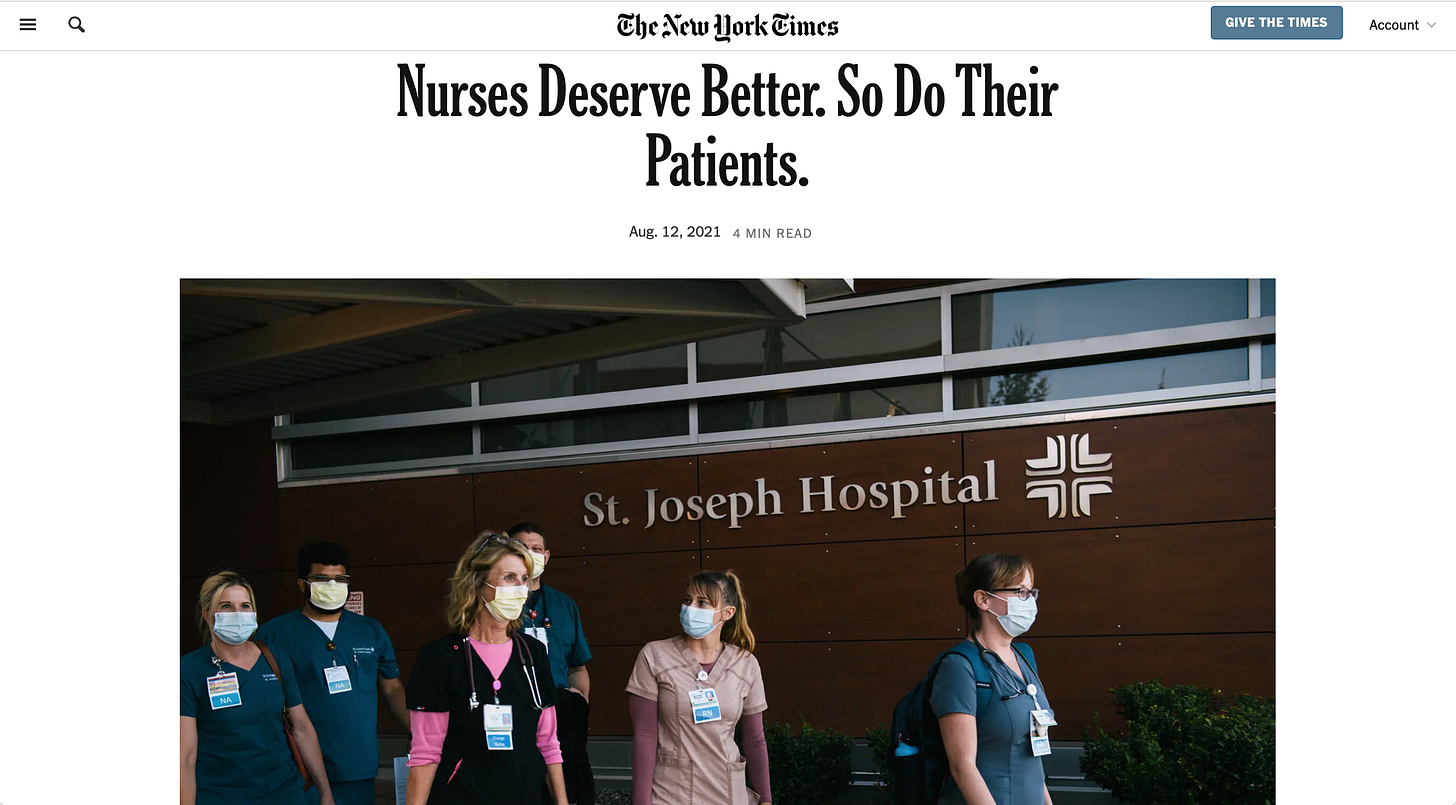An array of voices on nurse staffing
On one of the most urgent issues facing the profession, nurses are not a monolith
Letter from the editor
At the Robert Wood Johnson Foundation, we want to ensure nurses’ voices aren’t left out of the most important stories in healthcare. And over the past year, healthcare leaders have all been talking about an issue where the nursing angle is impossible to ignore: the crisis in adequately staffing hospitals and other care settings. Many healthcare executives now consider this to be the most urgent issue facing their institutions.
Particularly after the January strikes by nurses at several hospitals in New York City, the public has become more aware of the staffing crisis. In the new contracts that emerged from the strikes, nurses won not only higher pay, but mechanisms to ensure lower nurse-to-patient staffing ratios in the future. Now nearly every media report on nurse labor disputes, legislation, and education explains how the events relate to the number of nurses at the bedside. Legislative proposals to address staffing are under consideration in several states.
When I’m asked about nurse staffing, I emphasize two points. First, every conversation I have with nurses reinforces the urgency of this issue. It’s on everyone’s minds all the time. But second, nurses’ opinions about the nature of the problem or how to solve it are not a monolith. Nurses’ views vary greatly depending on where they serve in our healthcare system, as well as what aspect of the problem they are working on. There is certainly no one right answer.
After all, the workforce crisis is not just about nurse-to-patient ratios. It also overlaps with the problems of our educational pipeline, work-life balance, technology, burnout, physical and mental abuse, and racism in the healthcare system. No one perspective or solution can address all the moving parts.
For this reason, in this issue of What It Takes, we’ve decided to share a spectrum of nurse opinions on staffing and strikes. We also invite you to share your views in the comments section below.

Voices from the Frontlines
As negotiations in New York stalled, CNN ran an essay by Lauren Ghazal, a nurse practitioner in the city. Ghazal explained that nurses’ primary motivation for striking is to ensure their patients’ safety as well as their own:
What do nurses need right now? We need an investment in our health. We need to feel safe, respected and valued at work. As nurses (often referred to as the backbone of health care), we are committed to providing quality care to our community and the patients we serve. And in the end, our health impacts the health of all our patients.
In the featured video on the same page, CNN reporters interview New York State Nurses Association president Nancy Hagans on the state of negotiations, which would be resolved several days later.
The need to protect the health of patients and nurses was also front and center in a New York Daily News op-ed by a striking nurse from Mount Sinai Hospital. Matt Allen, an RN in the obstetrics unit, said he and his colleagues did not want to strike, but felt they had no other choice if they were to preserve the safety of their patients. He wrote:
I went into labor and delivery because supporting new parents and their babies is the most gratifying work I’ve ever done. It breaks my heart that a new mother’s experience of our hospital could be struggling to breastfeed her newborn for the first time without any support because her nurse is caring for double the number of newborns they’re supposed to.
As the New York strikes got underway, HuffPost produced a video that noted some of the disruptions in care, but primarily focused on the voices of the nurses in the streets. Michelle Gonzalez, an ICU nurse who has worked at Montefiore Medical Center for 10 years, told reporters:
The strike is a direct response to participating in care that you don’t feel is fulfilling. … A lot of us feel like this is a calling, and to provide care that makes you feel embarrassed or makes you have nightmares at night, it’s not okay and it’s not fair.
Of course, many nurses are facing extreme workloads far away from picket lines, as well. In a recent article for KevinMD.com, long-time ICU nurse Debbie Moore-Black explained that the increased patent load finally pushed her to resign:
My grand finale was when we were told we would have a 3:1 assignment in ICU. We were a high acuity ICU, 25 beds strong. … Our duties were endless. And it would be 12 to 13 grueling hours non-stop without a break. A 3:1 assignment was the end for me, as I truly felt that if I did not protect my nursing license that I worked hard for, then nobody would protect it. Not even my ICU Nurse manager. So I turned in my resignation. I said goodbye to my true love, ICU nursing.

Voices from Social Media
Particularly since the start of the COVID-19 pandemic, nurses have taken to social media to share the conditions they face on the job. In some cases, a single individual’s story can reach hundreds of thousands of people. That was the case with TikTok user @nurserbec, a nurse with more than 300,000 followers. Late last year, she broadcast a plea for the public to speak up about nurse-to-patient ratios in nursing homes.
Explaining that most nurses had exhausted their options for dealing with the problem through official channels, she said:
You can say call the state or don’t accept the assignment. Do you know how many times I have called the state? … The ratios have gotten so bad that not only am I genuinely worried about my license and my safety at work, but I am legitimately concerned about the safety of your family members.
She insists that the general public needs to get involved to solve the problem: “We are in a downward spiral and it is going to take some people who are not in the medical world to speak out and save us.”
Nurses are not just using social media to raise their voices on an individual level. In a widely covered case, nurses at a psychiatric facility in Buffalo claimed they were facing a 1:53 nurse-to-patient ratio, then made a video of themselves tracking down administrators to help with the problem. The video was later shared on Reddit and several nursing news sites.
Becker’s Hospital Review later reported that the facility was under investigation by the state. Representatives of the hospital explained to Becker’s that the dynamics they were managing had affected hospitals throughout the region due to difficulties in discharging psychiatric patients to state-supported programs. These issues have been covered in greater depth in The Buffalo News.
Sometimes nurses speaking up online leads to structural change. But for many, it is simply a place to cope. Forums such as Reddit (where most users go by pseudonyms) frequently feature memes and personal anecdotes that address the workforce crisis with dark humor. Some of the most popular posts of all time on the forum’s nursing thread feature stories of desperation from nurses in radically understaffed environments. In one post that drew more than 1,000 comments, a nurse expressed her fears that the health care system was at the breaking point, writing:
You cannot simultaneously ask us to act like we are a customer service business and also not provide any resources for us. If you want the patients to get good care, you need staff. If you want to reduce falls, you need staff. If you want staff, you need to pay and also treat them like human beings.

Nurse Leader Voices
Nurse leaders from across the profession acknowledge how frustrated their clinical counterparts have become. But there is considerable disagreement about what to do about it. In their essay for Medpage earlier this year, Katie Boston-Leary of the American Nurses Association and Sarah Delgado of the American Association of Critical-Care Nurses explained how fractious the conversation has become.
“The question of establishing specific nurse-to-patient ratios is the single most controversial topic in our profession and in healthcare right now," they wrote. This is ironic, they say, because at its core, a ratio is just a number. Looking at other fields, they argue that the healthcare system needs to do better:
As consumers in other industries, we pay attention to these numbers. We are mindful of class sizes at our children's schools (teachers:students), and airplanes do not fly without the proper number of flight attendants (flight attendants:passengers). When we go out to eat, we must wait to be seated even though we see empty tables, due to a lack of wait staff (servers:tables/patrons). And yet, in nursing, we remain stuck in this unsettling place of strikes, walkouts, and attrition.
The authors insist that just as important as the number itself is who gets to decide on it, pointing to the recommendation from the Partners for Nurse Staffing Think Tank that nursing specialty societies should take the lead.
Nurse leaders also draw attention to limitations in how many RNs the United States can currently produce. In its most recent survey of schools of nursing, the American Association of Colleges of Nursing reported that more than 90,000 qualified nursing school applicants were turned away last year, primarily due to a shortage of faculty.
In a recent piece for American Nurse, AACN president Deborah Trautman-- along with AACN communications officer Robert Rosseter and Susan Bakewell-Sachs, vice president for nursing affairs and dean of the school of nursing at Oregon Health & Science University in Portland-- addressed the issue. Calling for a “swift and unified” response to the problem, they outline steps that legislators, universities, nonprofits, and hospital systems can take to alleviate the shortage. They also cite the need for more flexibility between teaching and clinical roles.
“Removing the walls between education and practice will enable professional variety, role flexibility, and expertise sharing,” they write. “It also will support multiple missions if systems and roles are structured to offer meaningful and realistic lived experiences.”
However, other nurse leaders question whether the staffing crisis is really about a shortage of nurses at all. In a frequently cited essay in the New York Times from 2021, University of Pennsylvania nurse researcher Linda Aiken argued that the problem is not a lack of nurses, but working conditions that make it impossible for nurses to provide the care they were trained to deliver. She calls on states to follow the example of California and implement mandated nurse-to-patient ratios. Hoping for a better world on the other side of the pandemic, she wrote:
While we long to go back to pre-COVID life, returning to chronic nurse understaffing in hospitals, nursing homes and schools would be a big mistake. We owe nurses and ourselves better healthcare resources. The so-called nurse shortage has become an excuse for not doing more to make healthcare safe, effective and patient-centered. State legislators must do their job. Healthcare leaders must fund enough positions for nurses and create reasonable working conditions so that nurses will be there to care for us all.
Other influential nurse leaders are skeptical of state-mandated ratios. The editors of Nursing Economic$ recently noted that hospital administrators, including chief nursing officers, are usually dead set against what they view as an inflexible approach. Instead, they call for a broader discourse among healthcare leaders:
…demanding increased staffing without full discourse to reveal the pressures nurse executives, chief financial officers, and hospital executives experience daily would do little to solve the growing problem of understaffing. It fact, the opposite is more likely: expand the growing rift between those who recommend policy and those who must live with the consequences and pay the bills to take care of a sicker, more diverse population within the communities they serve.
Kathleen Bartholomew, who is known for her work on narrative and culture in healthcare, also weighed in against mandated ratios in an essay on Nurse.org. Instead, she called for a change of consciousness around nurses’ roles in healthcare:
Staffing ratios continue to keep nurses in an oppressed position and are a perfect example of learned helplessness. … We think we are exerting power, but we are not. It is pseudo-power designed to give nurses only a little bit of what they need. By fighting for ratios, we are still playing into the values of the dominant group. I want to wave a red flag and yell ‘Stop! There’s another way! Look!’ … The only person in an organization who is qualified to decide staffing levels is the charge nurse. … The charge nurse (with the support and endorsement of their manager) should get as many nurses as they request. Period. Fight for that!
Another kind of argument for a change in consciousness comes from across the Atlantic. This year, unprecedented nurse strikes also rocked England’s National Health Service. Reflecting on the conflict in an editorial in BMJ Quality & Safety, nurse researchers Peter Griffiths and Chiara Dall’Ora of the University of Southampton likened the nursing profession to the ancient myth of Cassandra, whose prophecies were always accurate but never believed. The authors argue that the evidence for a strong link between adequate nurse staffing and better health outcomes is irrefutable. The more troubling question, they write, is why authorities in healthcare and government do not act more urgently on this information:
Cassandra prophesied the fall of Troy. With many now fearing the collapse of the publicly funded NHS in the UK in the face of staffing shortages that have been predicted for some time, the message of this research is that you cannot deliver safe modern healthcare without enough registered nurses, including senior experienced clinical nurses, on hospital wards. It is time that those able to make decisions at a local and national level listened and acted.
Now It’s Your Turn
What do you want to say about the workforce crisis, nurse strikes, or policies to address the problem in the long term?




Thank you for shining light and holding the microphone for our fellow nurses.